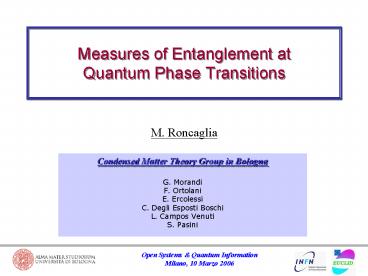Open Systems - PowerPoint PPT Presentation
1 / 21
Title: Open Systems
1
Measures of Entanglement at Quantum Phase
Transitions
M. Roncaglia
Condensed Matter Theory Group in Bologna
- G. Morandi
- F. Ortolani
- E. Ercolessi
- C. Degli Esposti Boschi
- L. Campos Venuti
- S. Pasini
2
- Entanglement is a resource for
teleportation dense coding quantum
cryptography quantum computation
- Strong quantum fluctuations in low-dimensional
quantum systems at T0
- The Entanglement can give another perspective
for understanding Quantum Phase Transitions
3
- Entanglement is a property of a state, not of an
Hamiltonian. But the GS of strongly correlated
quantum systems are generally entangled.
A
B
- Direct product states
- Nonzero correlations at T0 reveal entanglement
- 2-qubit states
Product states
Maximally entangled (Bell states)
4
Block entropy
B
A
- Reduced density matrix for the subsystem A
- Von Neumann entropy
- For a 11 D critical system
Off-critical
CFT with central charge c
l block size
See P.Calabrese and J.Cardy, JSTAT P06002
(2004).
5
Renormalization Group (RG)
- c-theorem
(Zamolodchikov, 1986)
- Massive theory (off critical)
- Block entropy saturation
Irreversibility of RG trajectories
Loss of entanglement
6
- Local Entropy when the subsystem A is a single
site.
- Applied to the extended Hubbard model
- The local entropy depends only on the average
double occupancy
- The entropy is maximal at the phase transition
lines - (equipartition)
S.Gu, S.Deng, Y.Li, H.Lin, PRL 93, 86402
(2004).
7
- Bond-charge Hubbard model
- (half-filling, x1)
- Critical points U-4, U0
- Negativity
- Mutual information
- Some indicators show
- singularities at transition points, while others
dont.
A.Anfossi et al., PRL 95, 056402 (2005).
8
Ising model in transverse field
- Critical point l1
- The concurrence measures the entanglement
between two sites after having traced out the
remaining sites.
- The transition is signaled by the first
derivative of the concurrence, which diverges
logarithmically (specific heat).
A.Osterloh, et al., Nature 416, 608 (2002).
9
Concurrence
For a 2-qubit pure state the concurrence is
(Wootters, 1998)
if
- Is maximal for the Bell states and zero for
product states
For a 2-qubit mixed state in a spin ½ system
10
Ising model in transverse field
2D classical Ising model CFT with central charge
c1/2
Critical point
Jordan-Wigner transformation
Exactly solvable fermion model
11
Near the transition (h1)
S1 has the same singularity as
Local (single site) entropy
Local measures of entanglement based on the
2-site density matrix depend on 2-point
functions
Nearest-neighbour concurrence inherits
logarithmic singularity
Accidental cancellation of the leading
singularity may occur, as for the concurrence at
distance 2 sites
12
Seeking for QPT point
Alternative FSS of magnetization
Standard route PRG
First excited state needed
C. Hamer, M. Barber, J. Phys. A Math. Gen.
(1981) 247.
Exact scaling function in the critical region
Crossing points
Shift term
13
Quantum phase transitions (QPTs)
Let
- First order discontinuity in
(level crossing)
- Second order
diverges for some
- At criticality the correlation length diverges
- GS energy
scaling hypothesis
- Differentiating w.r.t. g
14
- The singular term appears in every reduced
density - matrix containing the sites connected by .
- Local algebra hypothesis every local quantity
can be expanded - in terms of the scaling fields permitted by the
symmetries.
- Any local measure of entanglement contains the
singularity - of the most relevant term.
- Warning accidental cancellations may occur
depending on - the specific functional form next to
leading singularity
- The best suited operator for detecting and
classifying QPTs - is V , that naturally contains . Moreover,
FSS at criticality
15
Spin 1 l-D model
l
D
l Ising-like D single ion
Phase Diagram
- Symmetries U(1)xZ2
Around the c1 line
Critical exponents
16
Derivative
The same for
Crossing effect
- What about local measures
- of entanglement?
Using symmetries
Single-site entropy
L.Campos Venuti, et. al., PRA 73, 010303(R)
(2006).
17
F.Verstraete, M.Popp, J.I.Cirac, PRL 92, 27901
(2004).
Localizable Entanglement
- LE is the maximum amount of entanglement that
can - be localized on two q-bits by local
measurements.
j
i
N2 particle state
- Maximum over all local measurement basis
probability of getting
is a measure of entanglement
(concurrence)
18
L. Campos Venuti, M. Roncaglia, PRL 94, 207207
(2005).
Calculating the LE requires finding an optimal
basis, which is a formidable task in general
However, using symmetries some maximal (optimal)
basis are easily found and the LE takes a
manageable form
Spin 1/2
Spin 1
- Ising model
- Quantum XXZ chain
- MPS (AKLT)
LE max of correlation
LE string correlations
1
- The LE shows that spin 1 are
- perfect quantum channels but is insensitive to
phase transitions.
- The lower bound is attained
19
A spin-1 model AKLT
Bell state
Optimal basis
- Infinite entanglement length but finite
correlation length
- Actually in S1 case LE is related to string
correlation
Typical configurations
20
Conclusions
- Low-dimensional systems are good candidates for
Quantum Information devices.
- Several local measures of entanglement have been
proposed recently for the detection and
classification of QPT. (nonsystematic approach)
- Apart from accidental cancellations all the
scaling properties of local entanglement come
from the most relevant (RG) scaling operator.
- The most natural local quantity is ,
where g is the driving parameter - across the QPT.
- it shows a crossing effect
- it is unique and generally applicable
Advantages
- Localizable Entanglement ? It is related to some
already known correlation functions. It promotes
S1 chains as perfect quantum channels.
- Open problem Hard to define entanglement for
multipartite systems, - separating genuine quantum correlations and
classical ones.
References L.Campos Venuti, C.Degli Esposti
Boschi, M.Roncaglia, A.Scaramucci, PRA 73,
010303(R) (2006). L.Campos Venuti and M.
Roncaglia, PRL 94, 207207 (2005).
21
The End































